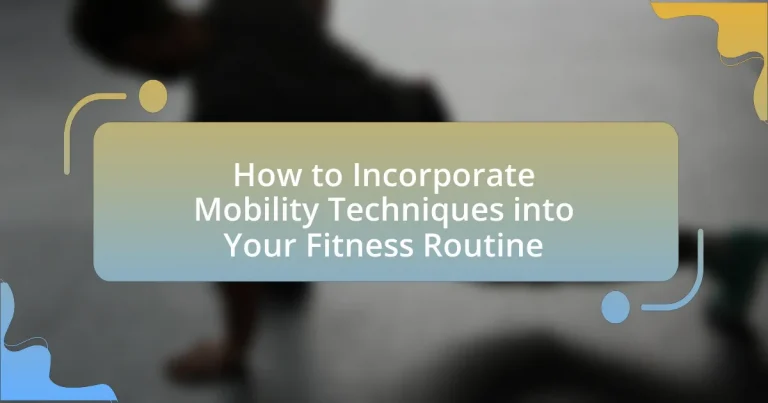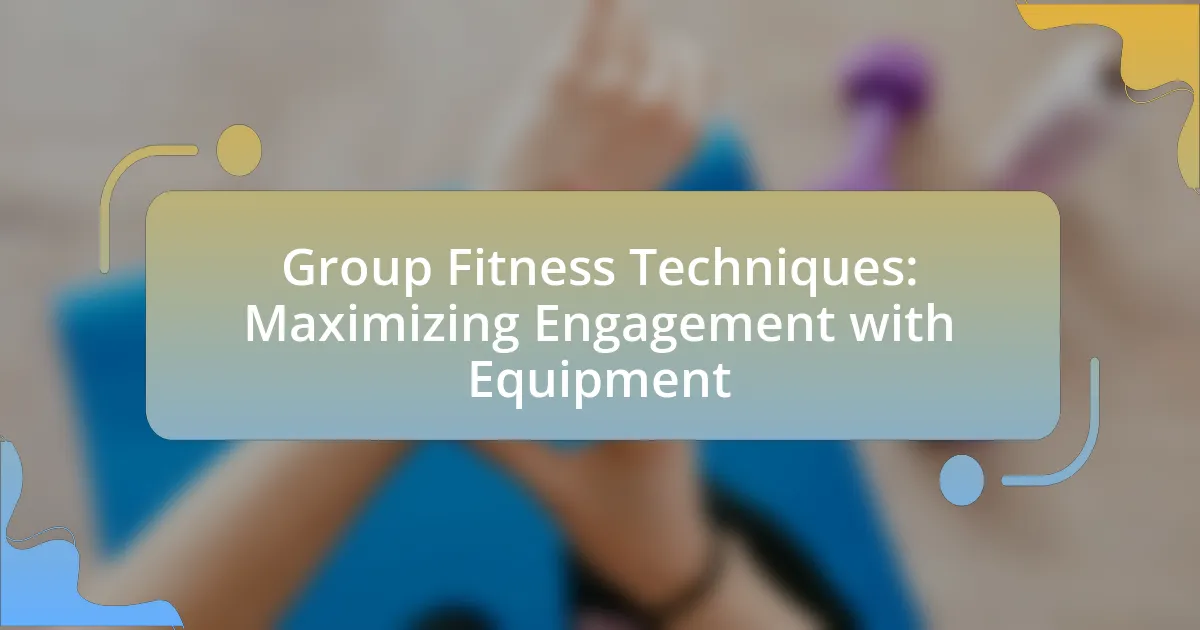Mobility techniques are exercises aimed at improving joint range of motion and overall movement quality, playing a crucial role in fitness by preventing injuries, enhancing performance, and aiding recovery. This article outlines the differences between mobility, flexibility, and strength training, highlighting the specific benefits of mobility techniques, such as increased flexibility and reduced injury risk. It also discusses various types of mobility exercises, including dynamic and static movements, and provides practical tips for effectively incorporating these techniques into fitness routines. Additionally, the article emphasizes the importance of consistency, goal-setting, and the use of tools to enhance mobility training, ensuring optimal results for individuals at different fitness levels.

What are Mobility Techniques and Why are They Important in Fitness?
Mobility techniques are exercises and practices designed to improve the range of motion in joints and enhance overall movement quality. These techniques are important in fitness because they help prevent injuries, improve performance, and facilitate better recovery. Research indicates that incorporating mobility work into a fitness routine can lead to increased flexibility, reduced muscle stiffness, and enhanced athletic performance, as evidenced by a study published in the Journal of Strength and Conditioning Research, which found that athletes who engaged in regular mobility training experienced significant improvements in their functional movement patterns.
How do mobility techniques differ from flexibility and strength training?
Mobility techniques focus on improving the range of motion and functional movement patterns, while flexibility training emphasizes the ability of muscles to stretch and strength training targets muscle power and endurance. Mobility exercises often involve dynamic movements that enhance joint function and coordination, such as hip circles or shoulder dislocates, which are essential for athletic performance and injury prevention. In contrast, flexibility training typically includes static stretches aimed at lengthening muscles, and strength training involves resistance exercises to build muscle mass and strength. Research indicates that incorporating mobility work can lead to better overall movement efficiency and reduced injury risk, as highlighted in studies on athletic performance and rehabilitation.
What specific benefits do mobility techniques provide for overall fitness?
Mobility techniques enhance overall fitness by improving joint range of motion, increasing flexibility, and reducing the risk of injury. Enhanced joint range of motion allows for better movement patterns during exercises, which can lead to more effective workouts. Increased flexibility contributes to improved performance in various physical activities, as it enables muscles to work more efficiently. Additionally, regular mobility work can help identify and address muscle imbalances, which are often precursors to injuries. Research indicates that individuals who incorporate mobility exercises into their routines experience fewer injuries and better recovery times, supporting the effectiveness of these techniques in promoting overall fitness.
How can mobility techniques prevent injuries during workouts?
Mobility techniques can prevent injuries during workouts by enhancing joint flexibility and range of motion, which reduces the risk of strains and sprains. Improved mobility allows for better movement patterns, ensuring that exercises are performed with proper form, thereby minimizing undue stress on muscles and joints. Research indicates that individuals who engage in regular mobility training experience fewer injuries; for instance, a study published in the Journal of Strength and Conditioning Research found that athletes incorporating mobility exercises into their routines had a 30% lower injury rate compared to those who did not. This evidence supports the effectiveness of mobility techniques in injury prevention during physical activity.
What types of mobility techniques can be incorporated into a fitness routine?
Mobility techniques that can be incorporated into a fitness routine include dynamic stretching, static stretching, foam rolling, and joint mobility exercises. Dynamic stretching involves moving parts of the body through a full range of motion to prepare muscles for activity, while static stretching focuses on holding a stretch for a period to improve flexibility. Foam rolling, a form of self-myofascial release, helps alleviate muscle tightness and improve blood flow. Joint mobility exercises target the range of motion in specific joints, enhancing overall movement quality. These techniques are supported by research indicating that they can improve performance, reduce injury risk, and enhance recovery in physical activities.
What are dynamic mobility exercises and how do they work?
Dynamic mobility exercises are movements designed to improve the range of motion and flexibility of joints through active motion. These exercises work by engaging muscles and joints in a controlled manner, promoting blood flow and preparing the body for physical activity. Research indicates that dynamic mobility exercises can enhance athletic performance and reduce the risk of injury by increasing joint lubrication and muscle elasticity. For example, studies have shown that athletes who incorporate dynamic stretching into their warm-up routines experience improved performance metrics compared to those who do not.
What are static mobility exercises and when should they be used?
Static mobility exercises are movements that involve holding a position to improve flexibility and range of motion in specific joints and muscles. These exercises should be used during warm-up routines to prepare the body for physical activity, as well as during cool-down sessions to aid recovery and enhance overall mobility. Research indicates that incorporating static mobility exercises can lead to improved athletic performance and reduced risk of injury by increasing joint stability and muscle elasticity.

How Can You Effectively Incorporate Mobility Techniques into Your Fitness Routine?
To effectively incorporate mobility techniques into your fitness routine, begin by integrating dynamic stretching and mobility drills before workouts to enhance range of motion and prevent injury. Research indicates that dynamic stretching can improve athletic performance and reduce the risk of injuries, as shown in a study published in the Journal of Strength and Conditioning Research, which found that athletes who performed dynamic stretches had better performance metrics compared to those who did not. Additionally, allocate specific time for static stretching and mobility work post-workout to aid recovery and flexibility. This structured approach ensures that mobility techniques are consistently practiced, leading to improved overall movement quality and performance in various physical activities.
What is the best way to integrate mobility techniques into existing workouts?
The best way to integrate mobility techniques into existing workouts is to incorporate dynamic stretching and mobility drills as part of the warm-up and cool-down phases. Dynamic stretching prepares the muscles and joints for activity, enhancing range of motion and reducing injury risk, while mobility drills improve joint function and flexibility. Research indicates that athletes who include mobility work in their routines experience better performance and reduced injury rates, as shown in a study published in the Journal of Strength and Conditioning Research, which found that dynamic warm-ups significantly improved athletic performance metrics.
How can you create a balanced routine that includes mobility work?
To create a balanced routine that includes mobility work, integrate mobility exercises into your existing workout schedule, ensuring they complement strength and cardio sessions. Mobility work should be performed at least three times a week, focusing on dynamic stretches before workouts and static stretches afterward to enhance flexibility and joint function. Research indicates that regular mobility training can improve athletic performance and reduce injury risk, as evidenced by a study published in the Journal of Strength and Conditioning Research, which found that athletes incorporating mobility drills experienced a 20% increase in range of motion and a 15% decrease in injury rates.
What are some common mistakes to avoid when incorporating mobility techniques?
Common mistakes to avoid when incorporating mobility techniques include neglecting proper warm-up, using incorrect form, and failing to progress gradually. Neglecting a warm-up can lead to injuries, as muscles and joints need to be prepared for movement. Using incorrect form during mobility exercises can exacerbate existing issues or create new ones, as improper alignment places undue stress on the body. Additionally, failing to progress gradually can result in overexertion, which may lead to soreness or injury; research indicates that gradual increases in intensity and duration are essential for safe and effective mobility training.
How often should mobility techniques be practiced for optimal results?
Mobility techniques should be practiced at least three to five times per week for optimal results. Regular practice enhances joint flexibility, range of motion, and overall functional movement, which are essential for effective performance in various physical activities. Research indicates that consistent engagement in mobility exercises can lead to significant improvements in athletic performance and injury prevention, as noted in a study published in the Journal of Strength and Conditioning Research, which found that participants who practiced mobility techniques regularly experienced enhanced physical capabilities compared to those who did not.
What factors influence the frequency of mobility training in a fitness routine?
The frequency of mobility training in a fitness routine is influenced by individual goals, physical limitations, and overall fitness levels. Individuals aiming for improved flexibility or injury prevention may prioritize mobility training more frequently. Additionally, those with specific physical limitations, such as joint stiffness or previous injuries, often require more consistent mobility work to maintain or enhance their range of motion. Research indicates that athletes and active individuals typically incorporate mobility training into their routines at least two to three times per week to optimize performance and recovery, as supported by findings from the National Strength and Conditioning Association.
How can you track progress in mobility training?
To track progress in mobility training, utilize specific metrics such as range of motion, flexibility assessments, and functional movement tests. These metrics provide quantifiable data that can be measured over time, allowing for objective evaluation of improvements. For instance, measuring the degrees of joint movement before and after a training period can illustrate enhancements in flexibility. Additionally, using tools like goniometers for precise angle measurements or video analysis to compare movement patterns can further validate progress. Regularly documenting these assessments creates a clear record of advancements, reinforcing the effectiveness of the mobility training regimen.

What are Some Practical Tips for Enhancing Mobility in Your Fitness Routine?
To enhance mobility in your fitness routine, incorporate dynamic stretching, foam rolling, and mobility drills. Dynamic stretching, such as leg swings and arm circles, prepares muscles for activity and improves range of motion. Foam rolling helps release muscle tightness and improve blood flow, which can enhance flexibility. Mobility drills, like hip openers and thoracic spine rotations, target specific joints and promote better movement patterns. Research indicates that regular mobility work can reduce injury risk and improve overall athletic performance, making these practices essential for a well-rounded fitness regimen.
What are the best mobility exercises for beginners?
The best mobility exercises for beginners include dynamic stretches such as arm circles, leg swings, and hip openers. These exercises enhance flexibility and range of motion, which are crucial for overall movement quality. Arm circles improve shoulder mobility, while leg swings target hip flexibility. Hip openers, such as the butterfly stretch, help in increasing hip joint mobility. Incorporating these exercises into a warm-up routine can significantly benefit beginners by preparing their bodies for more intense physical activity.
How can you modify mobility exercises for different fitness levels?
Mobility exercises can be modified for different fitness levels by adjusting the intensity, range of motion, and duration of the exercises. For beginners, simpler movements such as seated or standing stretches can be introduced, focusing on basic joint mobility without requiring advanced flexibility. Intermediate individuals can incorporate dynamic movements like leg swings or arm circles, increasing the range of motion and duration to enhance flexibility and strength. Advanced practitioners can perform complex movements such as deep squats or yoga flows, which require greater balance and coordination, thus challenging their mobility further. Research indicates that tailored mobility routines can improve overall performance and reduce injury risk, as seen in studies published in the Journal of Strength and Conditioning Research, which highlight the benefits of individualized exercise programs.
What tools or equipment can assist in mobility training?
Tools and equipment that can assist in mobility training include foam rollers, resistance bands, mobility balls, and balance boards. Foam rollers help release muscle tension and improve flexibility by applying pressure to tight areas. Resistance bands provide variable resistance, allowing for dynamic stretching and strengthening of muscles involved in mobility. Mobility balls, such as lacrosse balls, target specific muscle knots and enhance range of motion. Balance boards improve stability and proprioception, which are essential for effective mobility training. These tools are widely recognized in fitness and rehabilitation settings for their effectiveness in enhancing mobility.
How can you maintain motivation while incorporating mobility techniques?
To maintain motivation while incorporating mobility techniques, set specific, achievable goals related to mobility improvement. Research indicates that goal-setting enhances motivation by providing clear targets and a sense of accomplishment. For instance, tracking progress in flexibility or range of motion can reinforce commitment to a mobility routine. Additionally, integrating mobility techniques into enjoyable activities, such as yoga or dance, can sustain interest and engagement. Studies show that enjoyment in physical activities significantly correlates with adherence to fitness routines. Therefore, combining goal-setting with enjoyable practices can effectively maintain motivation in mobility training.
What strategies can help keep mobility training engaging and effective?
Incorporating variety and personalization into mobility training keeps it engaging and effective. Utilizing diverse exercises, such as dynamic stretches, yoga, and functional movements, prevents monotony and enhances overall flexibility. Personalizing routines based on individual goals and preferences increases motivation and adherence, as evidenced by a study published in the Journal of Sports Science, which found that tailored programs significantly improve participant engagement and outcomes. Additionally, integrating gamification elements, such as challenges or progress tracking, can further enhance motivation and enjoyment in mobility training sessions.
How can you set realistic goals for mobility improvement?
To set realistic goals for mobility improvement, first assess your current mobility levels through specific tests or evaluations. This assessment provides a baseline, allowing you to identify areas needing improvement. Next, establish SMART goals—Specific, Measurable, Achievable, Relevant, and Time-bound—tailored to your individual needs and capabilities. For example, instead of aiming to achieve full splits in a month, a more realistic goal could be to increase your hamstring flexibility by a measurable percentage over six weeks. Research indicates that gradual, consistent progress leads to better long-term outcomes in mobility training, as supported by studies on flexibility and injury prevention.





